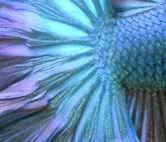Here is a sample of broken rays, typically happening on the caudal fin.

On one occasion, we noticed that the male - yes this broken rays typically happening on males - was overactive, which causes his caudal to bent too sudden and therefore break them off. This is pretty much similar if you try to swing your hand too sudden and you either sustain injury to your muscles or even break that bone if it hits something harder than your bone.
This type of broken rays is usually quite evenly distributed, forming a half circle on the caudal, which indicates that all of the rays protruding from the caudal are pretty much screwed.
On another occasion, we noticed that not only the caudal is experiencing the broken rays, other fins such as dorsal and anal are experiencing the same. This indicates that either it is caused by genetic or the environment. In our case, there is only 1 single male of the whole spawn experienced this, hence safely to assume that it is environmental. Another interesting thing about it, since it is "evenly distributed" to all fins, this brokenness forms a pattern. Analogy to this would be the pattern formed from tree trunk due to the growth of the tree. Over the time/years, tree forms circles in its trunk/girth. Water condition must have differ too greatly affecting the growth of the fins. The above example image seems to be of this 2nd type.
The troublesome concept of this broken rays is that we seems to experience this more on giant HMs rather than the standard HMs. The question is whether it is more prominant in giants compared to standard HM. One theory goes by saying that the weight of caudal fins is so great in giants - e.g. too heavy due to their size/thickness.
Time to monitor them and experiment on different water flow. Would stronger current affect this as well? It is known that strong currents can affect bend dorsal rays but is it strong enough to even bend/break rays?




No comments:
Post a Comment
Please do not put your email address on the comment to avoid being mined by spambot. Comment on posts older than a month will go through moderation (to avoid spam). Comments will not be filtered in any way - you would know, wouldn't you, cause you leave the comments to begin with :) Thanks for the comments!